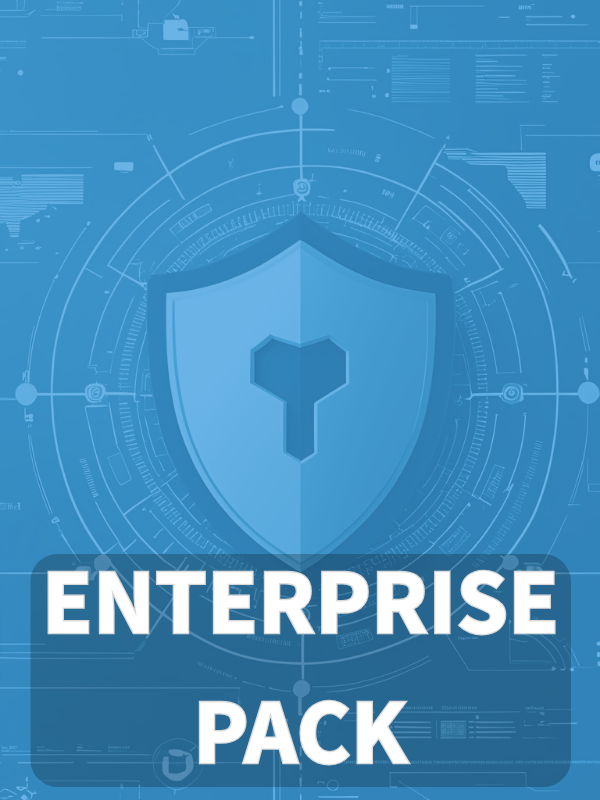Overview
This bundle provides a comprehensive set of policies for incident response, forensic evidence handling, business continuity, disaster recovery, secure backup, legal and regulatory compliance, and external communications, essential for maintaining enterprise resilience and fulfilling regulatory obligations across the organization.
Robust Incident Response
Formal structure for identification, analysis, containment, and post-incident review to minimize business impact.
Evidence and Forensic Integrity
Ensures legally defensible evidence collection, chain of custody, and compliance with global forensic standards.
Business Continuity & Disaster Recovery
Unified framework for continuity, disaster recovery planning, testing, and recovery of critical operations.
Legal & Regulatory Assurance
Tracks and embeds compliance with laws, standards, contractual, and sector-specific obligations throughout the organization.
Secure External Communications
Controls risks in social media and public messaging; ensures accuracy and regulatory compliance in all statements.
Read Full Overview
What's Inside
Incident Response Framework & Metrics
Forensic Evidence Collection & Chain of Custody
Business Impact Analysis, BCP & DRP Procedures
Backup, Restore, and Data Resilience Standards
Legal, Regulatory, and Contractual Compliance Controls
Social Media & External Communication Governance
Framework Compliance
🛡️ Supported Standards & Frameworks
This product is aligned with the following compliance frameworks, with detailed clause and control mappings.
| Framework | Covered Clauses / Controls |
|---|---|
| ISO/IEC 27001:2022 | |
| ISO/IEC 27002:2022 | |
| ISO 22301:2019 |
Business Continuity Management System Requirements
|
| NIST SP 800-53 Rev.5 | |
| NIST SP 800-34 Rev.1 |
Contingency Planning Framework
|
| NIST SP 800-101 Rev.1 |
Mobile-Media Forensics
|
| NIST SP 800-86 |
Integrating Forensic Techniques into Incident Response
|
| EU GDPR |
Article 5Article 6Article 24Article 32Article 33Article 34Recital 49
|
| EU NIS2 | |
| EU DORA | |
| COBIT 2019 |
Related Policies
Incident Response Policy
This policy establishes a formal structure for the identification, reporting, analysis, containment, response, recovery, and post-incident evaluation of information security incidents affecting the organization.
Evidence Collection And Forensics Policy
This policy establishes a structured, legally defensible framework for the identification, collection, preservation, analysis, and disposal of digital evidence during actual or suspected security incidents.
Business Continuity And Disaster Recovery Policy
This policy defines the mandatory controls and responsibilities for ensuring the organization’s ability to sustain or recover critical business operations and supporting ICT services during and after a disruptive incident.
Backup And Restore Policy
The purpose of this policy is to define the mandatory requirements for the backup and restoration of data, systems, and applications to support operational resilience, data integrity, and business continuity.
Legal And Regulatory Compliance Policy
This policy establishes the mandatory framework for identifying, managing, and complying with all legal, regulatory, and contractual obligations relevant to the organization’s information security, data privacy, and operational functions.
Social Media And External Communications Policy
This policy establishes mandatory rules and responsibilities governing the use of social media and all forms of external communication by personnel affiliated with the organization.
About Clarysec Policies - Mini Bundle: Incident Response & Business Continuity - ENT
Effective security governance requires more than just words; it demands clarity, accountability, and a structure that scales with your organization. Generic templates often fail, creating ambiguity with long paragraphs and undefined roles. This policy is engineered to be the operational backbone of your security program. We assign responsibilities to the specific roles found in a modern enterprise, including the CISO, IT Security, and relevant committees, ensuring clear accountability. Every requirement is a uniquely numbered clause (e.g., 5.1.1, 5.1.2). This atomic structure makes the policy easy to implement, audit against specific controls, and safely customize without affecting document integrity, transforming it from a static document into a dynamic, actionable framework.
Frequently Asked Questions
Built for Leaders, By Leaders
This policy was authored by a security leader with 25+ years of experience deploying and auditing ISMS frameworks for global enterprises. It's designed not just to be a document, but a defensible framework that stands up to auditor scrutiny.
